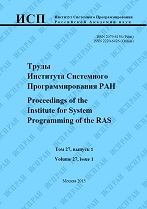|
This article is cited in 4 scientific papers (total in 4 papers)
Simulation of infrasound pistonphone
D. V. Golovin
All-Russian Scientific Research Institute of Physical Technical and Radiotechnical Measurements, Rosstandart
Abstract:
There are presented the results of numerical simulation of an applied acoustic problem – modeling of gas processes occurring in the measuring chamber of the infrasound pistonphone 3202 at different frequencies of piston oscillation ($0.1$ – $1000$ Hz) and characterized by extremely small Mach numbers ($9.1\cdot10^{-7}\div9.1\cdot10^{-3}$). The simulation was performed using quasi-gas-dynamic (QGD) and quasi-hydrodynamic (QHD) equations of a viscous compressible heat-conducting gas with the use of a time-explicit difference scheme, all spatial derivatives was approximated by central differences. It is shown that QGD and QHD models can be used for a simulation of applied acoustics and, in particular, to the simulation of infrasonic pistonphone: the stability limits of the QGD and QHD algorithms in this problem were determined, the dependence of sound pressure on the tuning parameter $\alpha$ is investigated and it is shown that this dependence is quite small. The spectra of sound pressure at the control point calculated by QGD and QHD are given, their dependence on the tuning parameter $\alpha$ is shown, both models equally predict the value of the sound pressure amplitude at the fundamental frequency oscillations. At the end of the article, the sound pressure at the control point at the fundamental frequency oscillations obtained by using QGD and QHD is compared with the values calculated by using semi-empirical formula of sound pressure at closed volume for a case of small oscillations using the polytropic index obtained by Henry Gerber instead of the adiabatic coefficient.
Keywords:
acoustic, infrasound, numerical simulation, quasi gas dynamic equations, quasi hydro dynamic equations.
Citation:
D. V. Golovin, “Simulation of infrasound pistonphone”, Proceedings of ISP RAS, 32:5 (2020), 181–198
Linking options:
https://www.mathnet.ru/eng/tisp553 https://www.mathnet.ru/eng/tisp/v32/i5/p181
|

| Statistics & downloads: |
| Abstract page: | 85 | | Full-text PDF : | 29 | | References: | 18 |
|




 Contact us:
Contact us: Terms of Use
Terms of Use
 Registration to the website
Registration to the website Logotypes
Logotypes







 Citation in format
Citation in format 
